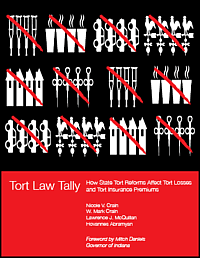San Francisco – The Pacific Research Institute (PRI), a free-market think tank based in California, released Tort Law Tally, a new report identifying which state tort reforms reduce tort losses and tort insurance premiums the most.

The analysis identifies 18 reforms to state civil-justice systems that significantly reduce tort losses and/or tort insurance premiums. The cumulative effect of reforms across all tort categories is a 47-percent reduction in losses and a 16-percent reduction in insurance premiums for consumers. “Our study helps state legislators and legal reformers identify which tort reforms produce the biggest bang for the buck,” said Lawrence J. McQuillan, PhD, project director and PRI director of Business and Economic Studies.
When tort reforms are ordered according to each reform’s ability to reduce aggregate tort losses, the top eight reforms are:
- attorney-retention sunshine (12-percent reduction)
- Daubert rule (10 percent)
- frivolous lawsuits (7 percent)
- jury service (6 percent)
- appeal-bond caps (4 percent)
- negligence standard (3 percent)
- non-economic-damage caps (2 percent)
- medical-malpractice damage caps (1 percent)
Some tort reforms are highly effective at reducing losses and premiums in certain tort categories, but are ineffective in other tort categories. “It’s important that tort reformers pick the right tool for the problems facing their state,” said Dr. McQuillan.
The methodology uses a quantitative analysis that compares losses and premiums in states that have implemented a particular tort reform to losses and premiums in states without this reform. The study assesses 25 specific reforms. Multivariate regression analysis controls for a number of factors that cause tort losses and premiums to vary among U.S. states.
From 1996 through 2005, more than 135 million civil lawsuits were filed in U.S. state courts. Approximately 15 percent of these civil cases were defined as torts. The payouts for tort losses and insurance premiums associated with state tort cases increased 60 percent in inflation-adjusted dollars from 1996 through 2005. In response to rising tortliability burdens, many states have enacted tort reforms with the goal of reducing tort costs. Dr. McQuillan explains: “This study provides data-driven evidence on which types of reforms are worth pushing, enacting, and defending.”
W. Mark Crain, one of four study co-authors and William E. Simon Professor of Political Economy at Lafayette College in Easton, Pennsylvania, concludes: “The findings from the analysis demonstrate the large potential for tort reforms to reduce both losses and insurance premiums associated with tort lawsuits.”
In contrast, Jon Haber, CEO of the American Association for Justice, the trial bar’s Washington, D.C., trade lobby, has proclaimed that “tort reform does not work.” Dr. McQuillan says: “Our rigorous statistical analysis proves that Mr. Haber is very wrong.”
Tort Law Tally
Lawrence J. McQuillan
San Francisco – The Pacific Research Institute (PRI), a free-market think tank based in California, released Tort Law Tally, a new report identifying which state tort reforms reduce tort losses and tort insurance premiums the most.
The analysis identifies 18 reforms to state civil-justice systems that significantly reduce tort losses and/or tort insurance premiums. The cumulative effect of reforms across all tort categories is a 47-percent reduction in losses and a 16-percent reduction in insurance premiums for consumers. “Our study helps state legislators and legal reformers identify which tort reforms produce the biggest bang for the buck,” said Lawrence J. McQuillan, PhD, project director and PRI director of Business and Economic Studies.
When tort reforms are ordered according to each reform’s ability to reduce aggregate tort losses, the top eight reforms are:
Some tort reforms are highly effective at reducing losses and premiums in certain tort categories, but are ineffective in other tort categories. “It’s important that tort reformers pick the right tool for the problems facing their state,” said Dr. McQuillan.
The methodology uses a quantitative analysis that compares losses and premiums in states that have implemented a particular tort reform to losses and premiums in states without this reform. The study assesses 25 specific reforms. Multivariate regression analysis controls for a number of factors that cause tort losses and premiums to vary among U.S. states.
From 1996 through 2005, more than 135 million civil lawsuits were filed in U.S. state courts. Approximately 15 percent of these civil cases were defined as torts. The payouts for tort losses and insurance premiums associated with state tort cases increased 60 percent in inflation-adjusted dollars from 1996 through 2005. In response to rising tortliability burdens, many states have enacted tort reforms with the goal of reducing tort costs. Dr. McQuillan explains: “This study provides data-driven evidence on which types of reforms are worth pushing, enacting, and defending.”
W. Mark Crain, one of four study co-authors and William E. Simon Professor of Political Economy at Lafayette College in Easton, Pennsylvania, concludes: “The findings from the analysis demonstrate the large potential for tort reforms to reduce both losses and insurance premiums associated with tort lawsuits.”
In contrast, Jon Haber, CEO of the American Association for Justice, the trial bar’s Washington, D.C., trade lobby, has proclaimed that “tort reform does not work.” Dr. McQuillan says: “Our rigorous statistical analysis proves that Mr. Haber is very wrong.”
Nothing contained in this blog is to be construed as necessarily reflecting the views of the Pacific Research Institute or as an attempt to thwart or aid the passage of any legislation.
Subscribe to our newsletter: